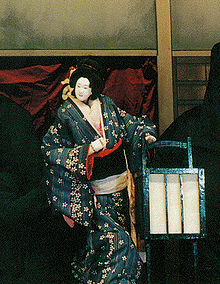Bunraku



Bunraku, also known as Ningyō jōruri, is a Japanese puppet theatre, founded in Osaka in the 17th century. It was mainly related to kabuki from Genroku period. Bunraku developed in Edo period combining puppet art with joruri. Bunraku has the narrator with puppets and the action is accompained by a game on the shamisen.
The most famous Japanese bunraku playwright is Chikamatsu Mozaemon. His most famous work is The Love Suicides at Sonezaki.
History[change | change source]
Originally the term bunraku referred to theatre founded in Osaka in 1805.
In Edo period, male pupeteers were hidden from the audience by the curtain while they held pupepts. The narrator and musician were also hidden. In 1703, pupeteers apperead in full view of the audience. In 1728, the narrator and musician were given their own stage. [1]
Related pages[change | change source]
References[change | change source]
- ↑ Skipitares, Theodora (2004). "The Tension of Modern Bunraku". PAJ: A Journal of Performance and Art. 26 (1): 13–21. doi:10.1162/152028104772624883. ISSN 1520-281X. JSTOR 3246436. S2CID 57569101.
